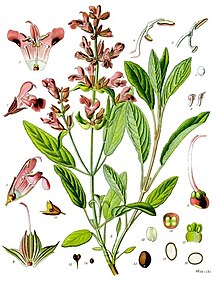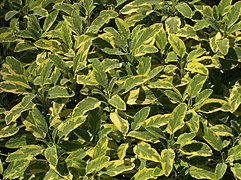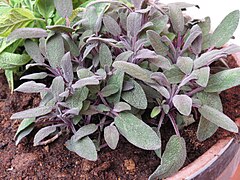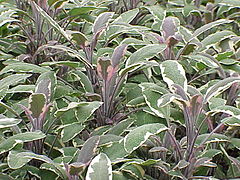The genus Thymus (/ˈtaɪməs/ TY-məs;[3] thymes) contains about 350[4] species of aromatic perennial herbaceous plants and subshrubs to 40 cm tall in the family Lamiaceae, native to temperate regions in Europe, North Africa and Asia. Thymus species are particularly concentrated in Iran, attributed to Iran's diverse climate and topographic/geographic location.[5]
Thyme is packed with phytonutrients, vitamins and minerals.[6] Thyme species such as T. fedtschenkoi, T. pubescens, and T. transcaucasicus have high amounts of essential oils; thymol and carvacrol.[7] These Thymus species are used for herbal tea, spice, and medicine.[7] The therapeutic effect of thyme is largely attributed to these essential oils belonging to the terpenoids family. [8]Thyme is considered amongst the most consequential medicinal plants due to its substantial amount of bioactive compounds.[9] Thyme has been used to treat diabetes, cold and chest infections, and coughs.[10] Thymus quinquecostatus Celak is an example of a Thyme species present in Korea.[11] In conventional Korean medicine, Thymus quinquecostatus Celak has been used to treat cancer, hepatic disease, and constipation.[12]
Stems tend to be narrow or even wiry; leaves are evergreen in most species, arranged in opposite pairs, oval, entire, and small, 4–20 mm long, and usually aromatic. Thyme flowers are in dense terminal heads with an uneven calyx, with the upper lip three-lobed, and are yellow, white, or purple.
Several members of the genus are cultivated as culinary herbs or ornamentals, when they are also called thyme after its best-known species, Thymus vulgaris or common thyme.
Thymus species are used as food plants by the larvae of some butterfly and moth insect species, including Chionodes distinctella and the Coleophora case-bearers C. lixella, C. niveicostella, C. serpylletorum, and C. struella (the latter three feed exclusively on Thymus).
Classification
A considerable amount of confusion has existed in the naming of thymes. Many nurseries use common names rather than binomial names, which can lead to mix-ups. For example golden thyme, lemon thyme, and creeping thyme are all common names for more than one cultivar. Some confusion remains over the naming and taxonomy of some species, and Margaret Easter (who holds the NCCPG National Plant Collection of thymes in the UK) has compiled a list of synonyms for cultivated species and cultivars.[13]
The most common classification is that used by Jalas, in eight sections: [14]
- Micantes: Iberian Peninsula and north Africa, includes T. caespititius
- Mastichina: Iberian Peninsula, includes T. mastichina
- Piperella: Monotypic section confined to the vicinity of Valencia, Spain
- Teucrioides: Balkan Peninsula
- Pseudothymbra: Iberian Peninsula and north Africa, includes T. cephalotos, T. longiflorus and T. membranaceus
- Thymus: Western Mediterranean region, includes T. camphoratus, T. carnosus, T. hyemalis, T. vulgaris and T. zygis
- Hyphodromi: Throughout the Mediterranean region, includes T. cilicicus and T. comptus
- Serpyllum: The largest section, throughout whole region, apart from Madeira and Azores, includes T. comosus, T. doerfleri, T. herba-barona, T. longicaulis, T. pannonicus, T. praecox, T. pulegioides, T. quinquecostatus, T. richardii, T. serpyllum, T. sibthorpii and T. thracicus
Cultivation
Thymus is cultivated for its fragrant leaves and used as a culinary herb in mediterranean cooking.[15]
Mrs Margaret Easter was appointed International Cultivar Registration Authority for the genus in 2007.[16]
Selected species
- Thymus adamovicii
- Thymus altaicus
- Thymus amurensis
- Thymus boissieri
- Thymus bracteosus
- Thymus broussonetii
- Thymus caespititius
- Thymus camphoratus
- Thymus capitatus
- Thymus capitellatus
- Thymus camphoratus
- Thymus carnosus
- Thymus cephalotus
- Thymus cherlerioides
- Thymus ciliatus
- Thymus cilicicus
- Thymus cimicinus
- Thymus citriodorus (Thymus × citriodorus) syn. T. fragrantissimus, T. serpyllum citratus, T. serpyllum citriodorum.[17] – citrus thyme
- Thymus comosus
- Thymus comptus
- Thymus curtus
- Thymus decussatus
- Thymus disjunctus
- Thymus doerfleri
- Thymus dubjanskyi
- Thymus glabrescens
- Thymus herba-barona
- Thymus hirsutus
- Thymus hyemalis
- Thymus inaequalis
- Thymus integer
- Thymus lanuginosus, syn. T. serpyllum – woolly thyme
- Thymus leucospermus
- Thymus leucotrichus
- Thymus longicaulis
- Thymus longiflorus
- Thymus mandschuricus
- Thymus marschallianus
- Thymus mastichina
- Thymus membranaceus
- Thymus mongolicus
- Thymus moroderi
- Thymus nervulosus
- Thymus nummularis
- Thymus odoratissimus
- Thymus pallasianus
- Thymus pallidus
- Thymus pannonicus
- Thymus praecox – creeping thyme
- Thymus proximus
- Thymus pseudolanuginosus, syn. T. serpyllum – woolly thyme
- Thymus pulegioides – lemon thyme[18]
- Thymus quinquecostatus
- Thymus richardii
- Thymus satureioides
- Thymus serpyllum
- Thymus sibthorpii
- Thymus striatus
- Thymus thracicus – lavender thyme
- Thymus villosus
- Thymus vulgaris – common thyme
- Thymus zygis
References
- ^ Linnaeus.Sp. Pl.: 590 (1753).
- ^ Kew World Checklist of Selected Plant Families
- ^ Sunset Western Garden Book. 1995. pp. 606–607.
- ^ "Thymus Linnaeus". Flora of China.
- ^ Emami Bistgani, Zohreh; Mamedov, Nazim; Lotfy Ashour, Mohamed (2022), Öztürk, Münir; Khan, Shujaul Mulk; Altay, Volkan; Efe, Recep (eds.), "Genus Thymus in Iran—Ethnobotany, Phytochemical, Molecular, and Pharmacological Features", Biodiversity, Conservation and Sustainability in Asia: Volume 2: Prospects and Challenges in South and Middle Asia, Cham: Springer International Publishing, pp. 817–848, doi:10.1007/978-3-030-73943-0_45, ISBN 978-3-030-73943-0, retrieved 2024-04-01
- ^ Hammoudi Halat, Dalal; Krayem, Maha; Khaled, Sanaa; Younes, Samar (2022-05-18). "A Focused Insight into Thyme: Biological, Chemical, and Therapeutic Properties of an Indigenous Mediterranean Herb". Nutrients. 14 (10): 2104. doi:10.3390/nu14102104. ISSN 2072-6643. PMC 9147557. PMID 35631245.
- ^ a b Hosseini, Naser; Ghorbanpour, Mansour; Mostafavi, Hossein (2024-02-13). "Habitat potential modelling and the effect of climate change on the current and future distribution of three Thymus species in Iran using MaxEnt". Scientific Reports. 14 (1): 3641. Bibcode:2024NatSR..14.3641H. doi:10.1038/s41598-024-53405-5. ISSN 2045-2322. PMC 10864348. PMID 38351276.
- ^ Patel, Vinood B.; Preedy, Victor R. (2020). Toxicology: oxidative stress and dietary antioxidants. London: Academic press, an imprint of Elsevier. ISBN 978-0-12-819092-0.
- ^ Nieto, Gema (2020-07-30). "A Review on Applications and Uses of Thymus in the Food Industry". Plants. 9 (8): 961. doi:10.3390/plants9080961. ISSN 2223-7747. PMC 7464319. PMID 32751488.
- ^ Kuete, Victor (2017). Medicinal spices and vegetables from Africa: therapeutic potential against metabolic, inflammatory, infectious and systemic diseases. [Amsterdam] London: Elsevier Academic press. ISBN 978-0-12-809286-6.
- ^ Kim, Minju; Sowndhararajan, Kandhasamy; Kim, Songmun (January 2022). "The Chemical Composition and Biological Activities of Essential Oil from Korean Native Thyme Bak-Ri-Hyang (Thymus quinquecostatus Celak.)". Molecules. 27 (13): 4251. doi:10.3390/molecules27134251. ISSN 1420-3049. PMC 9268194. PMID 35807496.
- ^ Kim, Minju; Sowndhararajan, Kandhasamy; Kim, Songmun (January 2022). "The Chemical Composition and Biological Activities of Essential Oil from Korean Native Thyme Bak-Ri-Hyang (Thymus quinquecostatus Celak.)". Molecules. 27 (13): 4251. doi:10.3390/molecules27134251. ISSN 1420-3049. PMC 9268194. PMID 35807496.
- ^ Easter, Margaret. "Thymus Synonyms". Retrieved 14 July 2008.
- ^ Jalas, Jaakko (1971). "Notes on Thymus L. (Labiatae) in Europe. I. Supraspecific classification and nomenclature". Bot. J. Linn. Soc. 64: 199–235.
- ^ "How to grow thyme". Royal Horticultural Society. Retrieved 12 October 2023.
- ^ Margaret, Easter. "Thymus Nomenclature". Thymus. Retrieved 12 October 2023.
- ^ Thymus x citriodorus - (Pers.)Schreb.. Plants for a Future.
- ^ USDA Thymus pulegioides
Sources
External links

Salvia officinalis, the common sage or sage, is a perennial, evergreen subshrub, with woody stems, grayish leaves, and blue to purplish flowers. It is a member of the mint family Lamiaceae and native to the Mediterranean region, though it has been naturalized in many places throughout the world. It has a long history of medicinal and culinary use, and in modern times it has been used as an ornamental garden plant. The common name "sage" is also used for closely related species and cultivars.
Names
Salvia officinalis has numerous common names. Some of the best-known are sage, common sage, garden sage, golden sage, kitchen sage, true sage, culinary sage, Dalmatian sage, and broadleaf sage. Cultivated forms include purple sage and red sage. The specific epithet officinalis refers to plants with a well-established medicinal or culinary value.[2]
Taxonomy
Salvia officinalis was described by Carl Linnaeus in 1753. It has been grown for centuries in the Old World for its food and healing properties, and was often described in old herbals for the many miraculous properties attributed to it.[3] The binary name, officinalis, refers to the plant's medicinal use—the officina was the traditional storeroom of a monastery where herbs and medicines were stored.[2][4] S. officinalis has been classified under many other scientific names over the years, including six different names since 1940 alone.[5] It is the type species for the genus Salvia.
Description

Cultivars are quite variable in size, leaf and flower color, and foliage pattern, with many variegated leaf types. The Old World type grows to approximately 60 cm (2 ft) tall and wide, with lavender flowers most common, though they can also be white, pink, or purple. The plant flowers in late spring or summer. The leaves are oblong, ranging in size up to 65 mm (2+1⁄2 in) long by 25 mm (1 in) wide. Leaves are grey-green, rugose on the upper side, and nearly white underneath due to the many short soft hairs. Modern cultivars include leaves with purple, rose, cream, and yellow in many variegated combinations.[3] The common sage gives its name to the grayish-green color sage, due to the distinctive color of its leaves.
History

Salvia officinalis has been used since ancient times for warding off evil, snakebites, increasing women's fertility, and more. The Romans referred to sage as the "holy herb," and employed it in their religious rituals.[6] Theophrastus wrote about two different sages, a wild undershrub he called sphakos, and a similar cultivated plant he called elelisphakos. Pliny the Elder said the latter plant was called salvia by the Romans, and used as a diuretic, a local anesthetic for the skin, a styptic, and for other uses. Charlemagne recommended the plant for cultivation in the early Middle Ages, and during the Carolingian Empire, it was cultivated in monastery gardens.[7] Walafrid Strabo described it in his poem Hortulus as having a sweet scent and being useful for many human ailments—he went back to the Greek root for the name and called it lelifagus.[8]
The plant had a high reputation throughout the Middle Ages, with many sayings referring to its healing properties and value.[9] It was sometimes called S. salvatrix (sage the savior). Dioscorides, Pliny, and Galen all recommended sage as a diuretic, hemostatic, emmenagogue, and tonic.[8] Le Menagier de Paris, in addition to recommending cold sage soup and sage sauce for poultry, recommends infusion of sage for washing hands at table.[10] John Gerard's Herball (1597) states that sage "is singularly good for the head and brain, it quickeneth the senses and memory, strengtheneth the sinews, restoreth health to those that have the palsy, and taketh away shakey trembling of the members."[11] Gervase Markham's The English Huswife (1615) gives a recipe for a tooth-powder of sage and salt.[12] It appears in recipes for Four Thieves Vinegar, a blend of herbs which was supposed to ward off the plague. In past centuries, it was also used for hair care, insect bites and wasp stings, nervous conditions, mental conditions, oral preparations for inflammation of the mouth, tongue and throat, and also to reduce fevers.[8]
Uses
Culinary use




In Britain, sage has for generations been listed as one of the essential herbs, along with parsley, rosemary, and thyme (as in the folk song "Scarborough Fair"). It has a savory, slightly peppery flavor. Sage appears in the 14th and 15th centuries in a "Cold Sage Sauce", known in French, English and Lombard cuisine, probably traceable to its appearance in Le Viandier de Taillevent.[13] It appears in many European cuisines, notably Italian, Balkan and Middle Eastern cookery. In Italian cuisine, it is an essential condiment for saltimbocca and other dishes, favored with fish. In British and American cooking, it is traditionally served as sage and onion stuffing, an accompaniment to roast turkey or chicken at Christmas or Thanksgiving Day, and for Sunday roast dinners. Other dishes include pork casserole, Sage Derby cheese and Lincolnshire sausages. Despite the common use of traditional and available herbs in French cuisine, sage never found favor there.
Essential oil
Common sage is grown in parts of Europe for distillation of an essential oil, although other species such as Salvia fruticosa may also be harvested and distilled with it.[citation needed]
Research
Extracts of Salvia officinalis and S. lavandulaefolia are under preliminary research for their potential effects on human brain function.[14][15] The thujone present in Salvia extracts may be neurotoxic.[15]
Cultivars
In favourable conditions in the garden, S. officinalis can grow to a substantial size (1 square metre or more), but a number of cultivars are more compact. As such they are valued as small ornamental flowering shrubs, rather than for their herbal properties. Some provide low ground cover, especially in sunny dry environments. Like many herbs they can be killed by a cold wet winter, especially if the soil is not well drained. But they are easily propagated from summer cuttings, and some cultivars are produced from seeds.
Named cultivars include:
- 'Alba', a white-flowered cultivar
- 'Aurea', golden sage
- 'Berggarten', a cultivar with large leaves, which rarely blooms, extending the useful life of the leaves
- 'Extrakta', has leaves with higher oil concentrations
- 'Icterina', a cultivar with yellow-green variegated leaves
- 'Lavandulaefolia', a small leaved cultivar
- 'Purpurascens' ('Purpurea'), a purple-leafed cultivar
- 'Tricolor', a cultivar with white, purple and green variegated leaves
'Icterina'[16] and 'Purpurascens'[17] have gained the Royal Horticultural Society's Award of Garden Merit.[18]
-
'Berggarten'
-
'Icterina'
-
'Purpurascens'
-
'Tricolor'
See also
References
- ^ Allen, D.J. (2014). "Salvia officinalis". IUCN Red List of Threatened Species. 2014: e.T203260A2762648. doi:10.2305/IUCN.UK.2014-1.RLTS.T203260A2762648.en. Retrieved 23 January 2024.
- ^ a b Harrison, Lorraine (2012). RHS Latin for gardeners. United Kingdom: Mitchell Beazley. p. 224. ISBN 9781845337315.
- ^ a b Clebsch, Betsy; Carol D. Barner (2003). The New Book of Salvias. Timber Press. p. 216. ISBN 978-0-88192-560-9.
- ^ Stearn, William T. (2004). Botanical Latin. Timber Press (OR). p. 456. ISBN 978-0-88192-627-9.
- ^ Sutton, John (2004). The Gardener's Guide to Growing Salvias. Workman Publishing Company. p. 17. ISBN 978-0-88192-671-2.
- ^ Greer, John Michael (2017). The Encyclopedia of Natural Magic (First ed.). Woodbury, MN: Llewellyn Publications. p. 185. ISBN 9780738706740.
- ^ Watters, L. L. (1901). An Analytical Investigation of Garden Sage (Salvia officinalis, Linne). New York: Columbia University.
- ^ a b c Kintzios, Spiridon E. (2000). Sage: The Genus Salvia. CRC Press. pp. 10–11. ISBN 978-90-5823-005-8.
- ^ An Anglo-Saxon manuscript read "Why should man die when he has sage?" Kintzios, p. 10
- ^ "Le Menagier de Paris". Hinson, Janet, translator. 1393.
{{cite web}}: CS1 maint: others (link) - ^ Grieve, Maud (1971). A Modern Herbal: The Medicinal, Culinary, Cosmetic and Economic Properties, Cultivation and Folk-lore of Herbs, Grasses, Fungi, Shrubs, & Trees with All Their Modern Scientific Uses, Volume 2.
- ^ Markham, Gervase (1615). The English House-wife.
- ^ Le Viandier de Taillevent: 14th Century Cookery, Based on the Vatican Library Manuscript. Translated by Prescott, James. Eugene, Oregon: Alfarhaugr Publishing Society. 1989. p. 27. ISBN 978-0-9623719-0-5. Archived from the original on 2021-03-02. Retrieved 2018-03-12.
- ^ Miroddi M, Navarra M, Quattropani MC, Calapai F, Gangemi S, Calapai G (2014). "Systematic review of clinical trials assessing pharmacological properties of Salvia species on memory, cognitive impairment and Alzheimer's disease". CNS Neurosci Ther. 20 (6): 485–95. doi:10.1111/cns.12270. PMC 6493168. PMID 24836739.
- ^ a b Lopresti AL (2017). "Salvia (Sage): A Review of its Potential Cognitive-Enhancing and Protective Effects". Drugs in R&D. 17 (1): 53–64. doi:10.1007/s40268-016-0157-5. PMC 5318325. PMID 27888449.
- ^ "RHS Plant Selector - Salvia officinalis 'Icterina'". Retrieved 5 March 2021.
- ^ "RHS Plant Selector - Salvia officinalis 'Purpurascens'". Retrieved 5 March 2021.
- ^ "AGM Plants - Ornamental" (PDF). Royal Horticultural Society. July 2017. p. 94. Retrieved 12 October 2018.






Recent Comments